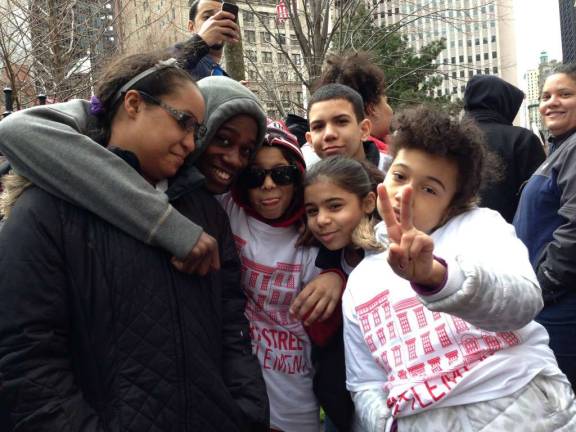Save After-School Programs

Leaders and students from Upper East Side after-school programs rally to keep them off the budget chopping block "Invest in us; we'll rise to the top. Give us a little, we'll grow a lot!" This was the rally cry of the 700 children and after-school advocates that attended the March 28th rally outside City Hall to save child care and after-school programs. Dozens of after-school programs citywide, including Stanley Isaacs Neighborhood Center on East 93rd Street, brought representatives to the rally to protest the extreme proposed budget cuts. Mayor Bloomberg's proposed fiscal plan in 2014 would cut $130 million from after-school programs and leave 47,000 children without a place to go after the school day. "I think what we want to look at is how kids are staying in school and how our and how these programs build the skills of our youth," said Cathleen Fitzgibbons, of the Federation of Protestant Welfare Agencies, one of the sponsors of the rally, along with the Campaign for Children. "These programs are critical for their overall development, and for shaping them as they're going through middle school and high school." The rally was packed with hundreds of advocates, who brought signs and posters pronouncing their love for the after-school programs: "Help Keep After School Alive!" and "Do Not Close Child Care!" Matt Phifer, Director of Educational Services from the Henry Street Settlement on the Lower East Side, led the rally as MC. He brought to the stage numerous council members like District 6's Gale Brewer, as well as District 8's Melissa Mark-Viverito, who both touted the educational importance of these programs. Gale Brewer explained that every year for the past 12 years, the mayoral office has done this "budget dance" where they cut programs they know the City Council can restore. "The uncertainty is still scary," said Council Member Brewer. Children from the after-school programs showed off their extracurricular skills on stage - from double-dutch, to singers and traditional drummers, making for quite an exuberant scene. As for the kids in the crowd, many of the younger students said that they loved playing sports like dodgeball and rugby in their after-school programs. But the older teenagers conceded that the programs keep them off the streets and out of trouble. "Visibility was great. It was a perfect storm of different concerned parties," said Phifer. "Hopefully we will be able to make some change." Mayor Bloomberg has not yet responded to the pleas of families impacted by these budget proposals. "We're working with the City Council to deliver an on-time, balanced budget that keeps the city's fiscal house in order, while also protecting vital services," said City Hall spokeswoman Lauren Passelacqua.(http://nypress.com/wp-content/uploads/2013/04/Childcare-Cuts.jpg) The budget right now has not included any of the City Council's one-year funds, which would cause hundreds of programs to have to shut their doors completely. In addition the $10 million proposed cut would slash after-school slots by 75 percent. This struggle is not new - just last year, similar budget cuts were proposed. But after several rallies last year, many of the funds were actually restored for one more year, according to Phifer. Emma Woods, a representative from the Campaign for Children, an organization that was started last year in response to the budget difficulties and one of the rally's sponsors, said that the Mayor should just baseline the money for these programs in his budget, so that this fight would not have to happen year after year. "In the long term, the goal would be to no longer put these programs on the chopping block," said Woods. "As the number of kids served goes down, poverty increases." And there are other measurable benefits too. A Wallace Foundation Evaluation of Out of School Time Programs in 2006 found that 56 percent of program participants felt that the programs really got them interested and involved in activities outside school. Plus 69 percent of participating students said that they made more friends in the program. Besides social skills, most of the students surveyed felt that their schoolwork improved. So what would happen to those benefits if budgets were slashed? For Stanley Isaacs Center, the Upper East Side organization at the rally, budget cuts would be devastating. They have four after school programs, and would basically have to chop one completely (P.S. 112), if the budget proposal passed. At P.S. 112, right now, they can only serve 80 kids, with a waitlist of dozens of students who want to participate in the program, said Jeanine Glazewski, the Director of Development at Stanley Isaacs, which oversees a low-income area. She also said that these programs decrease delinquency. One of their board members is Marianne Hedges, the woman who was hit in the head with a shopping cart thrown from the roof of a building over the summer. "These are just kids with nothing better to do we after school," said Glazewski. "We would much rather have them doing homework, arts and sports." Plus, she said, the after school programs allows parents to go to jobs or do job training/searches. Many of these parents, she said, cannot afford caretakers. So, if there were no after school programs, the parents would have to quit their jobs in order to provide an environment for their children. "Parents feel strongly about this, but it becomes more and more difficult," said Glazewski."People think 'oh this again? Didn't we fight this last year?' When you have to go and argue for something that is creating longterm benefits of the city, you know there's a problem."